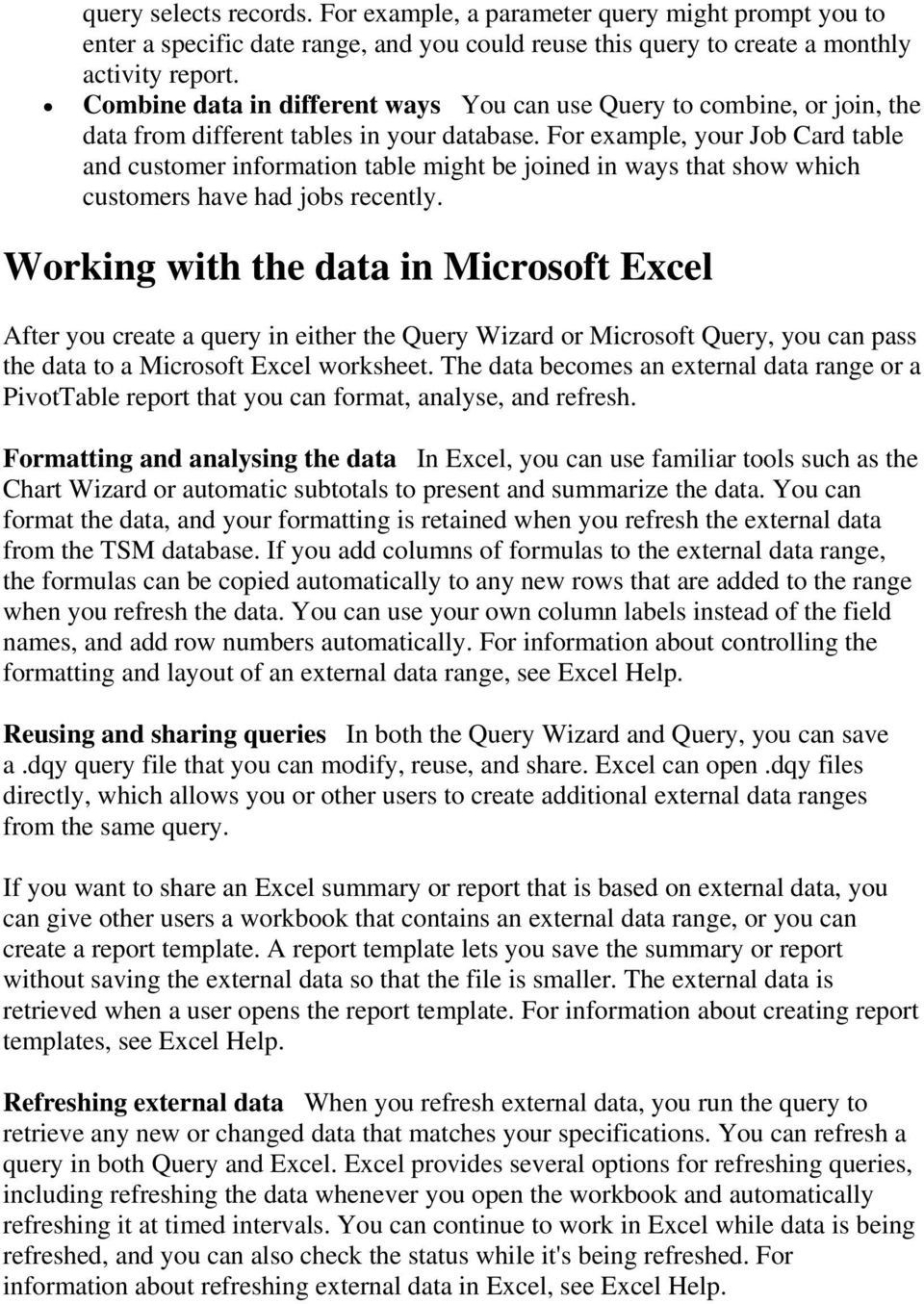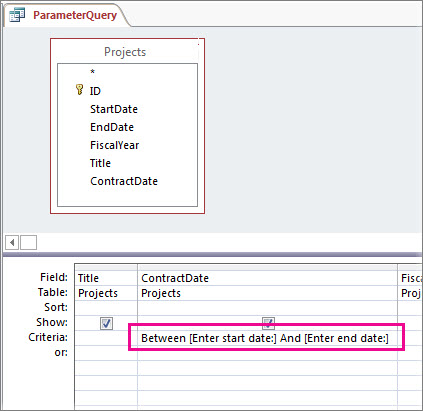Date Parameters In Microsoft Query Wizard
With the query open in Design view, on the Design tab, in the Show/Hide group, click Parameters. In the Query Parameters dialog box, in the Parameter column, type the prompt for each parameter for which you want to specify the data type. Make sure that each parameter matches the prompt that you use in the Criteria row of the query design grid. The parameter values should come from cells in Excel, and the data should be refreshed automatically anytime the value of any parameter changes in the grid. Oldest method: MS-Query. Oddly enough, the oldest method of MS-Query is the easiest, and doesn’t require any use of VBA. Hi, I have switched lately from Access 2013 to Access 2016, since then my simple 'Dates' parameter query doesn't work anymore. I was using these parameters in my 'Date' field = From Report Date yyyy/mm/dd And Date yyyy/mm/dd I got zero records as a result, but if I hardcore this. The name of the parameter. Assigned to the Name property of the Parameter object and used to identify this parameter in the Parameters collection. You can use name as a string that is displayed in a dialog box while your application runs the query. Use brackets ( ) to enclose text that contains spaces or punctuation. Add a Query Parameter to Create a Report Parameter. When you add a query parameter to a query, Report Builder automatically creates a single-valued report parameter with default properties for name, prompt, and data type. To add a query parameter. Click Design to switch back to Design view. In the Report Data pane, expand the Datasets folder.
The Simple Query Wizard does a great deal of the work of creating a queryfor you. It's most useful when you want to use fields from different tablesand when you want a query that summarizes your data.
The Simple Query Wizard gives you the option of creating either a summary(totals) query or a detail query. A detail query lists every record that meetsyour criteria. A summary query (also called a totals query) performs calculationson your data to summarize it. You can create a summary query if the fields you choose for the query include both of the following:
- A field with values
- A field with repetitions or a field with dates, used to group the values
Car mechanic simulator 2015 - bentley. A summary query gives you the option of totaling (summing), averaging,counting the number of values in a field, or finding the minimum or maximumvalue in a field. A summary query creates new calculated fields thatyou can use in other queries or in reports.
If you have a field that lists the amount spentand a field that lists the dates on which the money was spent, the SimpleQuery Wizard creates a summary query for you that sums the amount spent by date.
Ready to give the Simple Query Wizard a spin? Just follow these steps to usethe wizard to create a query:
Microsoft Query Parameters
- Display the Create tab on the Ribbon and click the Query Wizard button.
- Select Simple Query Wizard from the New Query dialog box and click OK.
Access displays the first window of the Simple Query Wizard. - Use the Tables/Queries list box to choose the first table or query that you want to use fields from.
Many queries are based on tables, but you also have the option ofbasing a query on another query. For instance, maybe you already createda query to select sales data from only the year 2003. Now, withoutmodifying the original query, you want to create a query that lists 2003sales by state, or limits the analysis to just a few salespeople.
When you select a table or query, fields from that object appear in the Available Fields list box. - Move the fields you want to use in the query from the Available Fieldslist to the Selected Fields list by double-clicking a field name (or byselecting the field name and then clicking the > button).
- If you're using fields from more than one table or query, repeat Steps2 and 3 to add fields from the additional tables or queries to theSelected Fields list and then click Next.
From this point on, the windows you see depend upon the types of fieldsand the type of query (detail or summary) you choose. - Choose the type of query you want: Detail or Summary. Depending onyour selection, do one of the following:
- If you choose a summary query, click the Summary Options button.
- f you choose a detail query, click Next and jump to Step 9.
- Choose how to summarize your data and click OK to close theSummary Options dialog box. Then click Next to see the next window of the wizard.
Use the check boxes to indicate the new fields you want Access to create.For example, if you want to add all the values in the Qty field (to calculatehow many of each item have been sold), click the Sum check box in the row for the Qty field.
Don't overlook the Count check box(es) that may appear in thiswindow - selecting a Count check box tells the wizard to create afield that counts the records within each grouping. - If the fields being summarized can be grouped by a Time/Date field,choose the time interval the records should be grouped by and click Next.
You will not see this window if your data does not contain a Time/Date field.
For example, if you choose to include the Order Date field in the queryand to sum the Qty field, you can group by month to see how many ofeach item you sold in each month. You can choose to display total checkamounts by the following options: Day, Month, Quarter, or Year. TheUnique Day/Time option groups records by each unique date and time;if your data includes times, each record with the same date and time isgrouped together. If your data only includes a date without the time,each record from the same day is grouped together (which is the same as the Day option). - Type a name for the query in the box at the top of the window.
Choose from these options:- Open the Query to View Information: This option shows you the query in Datasheet view.
- Modify the Query Design: This option shows you the query in Design view.
- Display Help on Working With the Query: Click this check box if you want to see the help screen that covers working with a query.
- Click Finish to view the query.
If you chose the Open the Query to View Information option, you see thequery in Datasheet view. If you chose the Modify the Query Design option, you see your resulting query datasheet.
Date Parameters In Microsoft Query Wizard Key
You can edit the query created by the Simple Query Wizard using Design view, (about which there's lots more in the rest of this tutorial).
The Simple Query Wizard doesn't allow you to include criteria to choose which records you want to include in the query datasheet. If you want toinclude criteria in your query, open the query created by the wizard in Design view and add the criteria. (Details of Design view appear throughout this tutorial.)
In this tutorial:
Date Parameters In Microsoft Query Wizard Download
This MSAccess tutorial explains how to create a query that accepts a start date and an end date as parameters in Access 2003 (with screenshots and step-by-step instructions).

Question: In Microsoft Access 2003/XP/2000/97, I'm trying to run a query based on a date. When the query opens, I would like some type of window prompting for the user to enter a 'start' date and an 'end' date. How can I do this?
Painkiller hell & damnation download free. Answer: You can create a parameter query that prompts for both a 'start' date and an 'end' date.
To do this, first create your query.
Then enter your 'start' date and 'end' date parameters. Parameters should be enclosed in square brackets as follows:
This will create a parameter called [Start Date] and a parameter called [End Date]. So that only those records from the Orders table will be returned where the OrderDate field is between these two dates.
Next, you probably want to ensure that the user enters a valid date in these two parameters. To do this, select Parameters under the Query menu.

When the Query Parameters window appears, enter the two parameters [Start Date] and [End Date], and select Date/Time as the data type. Click on the OK button.
Now, when you run the query, you will be prompted to enter the 'start' date.
Then prompted to enter the 'end' date.
Microsoft Query Wizard
Your query will then only return the records where the OrderDate is between these two values.